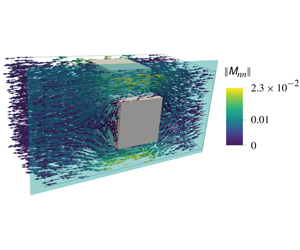Crossref Citations
This article has been cited by the following publications. This list is generated based on data provided by
Crossref.
Valdés-Parada, F. J.
and
Lasseux, D.
2021.
Flow near porous media boundaries including inertia and slip: A one-domain approach.
Physics of Fluids,
Vol. 33,
Issue. 7,
Ciuti, M.
Zampogna, G. A.
Gallaire, F.
Camarri, S.
and
Ledda, P. G.
2021.
On the effect of a penetrating recirculation region on the bifurcations of the flow past a permeable sphere.
Physics of Fluids,
Vol. 33,
Issue. 12,
Ledda, Pier Giuseppe
Boujo, E.
Camarri, S.
Gallaire, F.
and
Zampogna, G.A.
2021.
Homogenization-based design of microstructured membranes: wake flows past permeable shells.
Journal of Fluid Mechanics,
Vol. 927,
Issue. ,
Marshall, Kevin J.
and
Brady, John F.
2021.
The hydrodynamics of an active squirming particle inside of a porous container.
Journal of Fluid Mechanics,
Vol. 919,
Issue. ,
Peng, Zhiwei
Zhou, Tingtao
and
Brady, John F.
2022.
Activity-induced propulsion of a vesicle.
Journal of Fluid Mechanics,
Vol. 942,
Issue. ,
Jain, Sahaj
and
Sudhakar, Y.
2022.
Prediction of drag components on rough surfaces using effective models.
Physics of Fluids,
Vol. 34,
Issue. 7,
Zampogna, Giuseppe Antonio
Ledda, Pier Giuseppe
and
Gallaire, François
2022.
Transport across thin membranes: Effective solute flux jump.
Physics of Fluids,
Vol. 34,
Issue. 8,
Zampogna, Giuseppe A.
Ledda, P.G.
Wittkowski, K.
and
Gallaire, F.
2023.
Homogenization theory captures macroscopic flow discontinuities across Janus membranes.
Journal of Fluid Mechanics,
Vol. 970,
Issue. ,
Vagnoli, Giovanni
Zampogna, G.A.
Camarri, S.
Gallaire, F.
and
Ledda, P.G.
2023.
Permeability sets the linear path instability of buoyancy-driven disks.
Journal of Fluid Mechanics,
Vol. 955,
Issue. ,
Kuchibhotla, Vedanth Narayan
Sahoo, Sujit Kumar
and
Sudhakar, Y.
2023.
A method to extract macroscopic interface data from microscale rough/porous wall flow fields.
Physics of Fluids,
Vol. 35,
Issue. 10,
Caruso Lombardi, F.
Bongarzone, A.
Zampogna, G. A.
Gallaire, F.
Camarri, S.
and
Ledda, P. G.
2023.
Von Kármán vortex street past a permeable circular cylinder: Two-dimensional flow and dynamic-mode-decomposition-based secondary stability analysis.
Physical Review Fluids,
Vol. 8,
Issue. 8,
Molefe, Lebo
Zampogna, Giuseppe A.
Kolinski, John M.
and
Gallaire, François
2024.
Coating thickness prediction for a viscous film on a rough plate.
Journal of Fluid Mechanics,
Vol. 1001,
Issue. ,
Marchand, Olivier C.
Ramananarivo, Sophie
Duprat, Camille
and
Josserand, Christophe
2024.
Three-dimensional flow around and through a porous screen.
Journal of Fluid Mechanics,
Vol. 987,
Issue. ,
Corsi, G.
Ledda, P. G.
Vagnoli, G.
Gallaire, F.
and
De Simone, A.
2024.
Instability and trajectories of buoyancy-driven annular disks: A numerical study.
Physical Review Fluids,
Vol. 9,
Issue. 4,
Wittkowski, K.
Ponte, A.
Ledda, P.G.
and
Zampogna, G.A.
2024.
Quasi-linear homogenization for large-inertia laminar transport across permeable membranes.
Journal of Fluid Mechanics,
Vol. 1000,
Issue. ,
Wittkowski, Kevin
Boujo, Edouard
Gallaire, François
and
Zampogna, Giuseppe Antonio
2025.
Adjoint-aided homogenisation for flows through heterogeneous membranes.
Journal of Fluid Mechanics,
Vol. 1011,
Issue. ,
